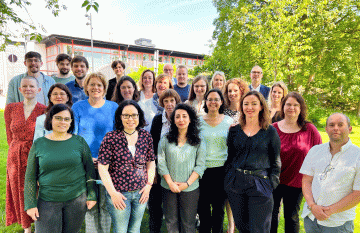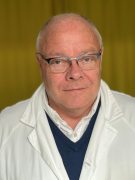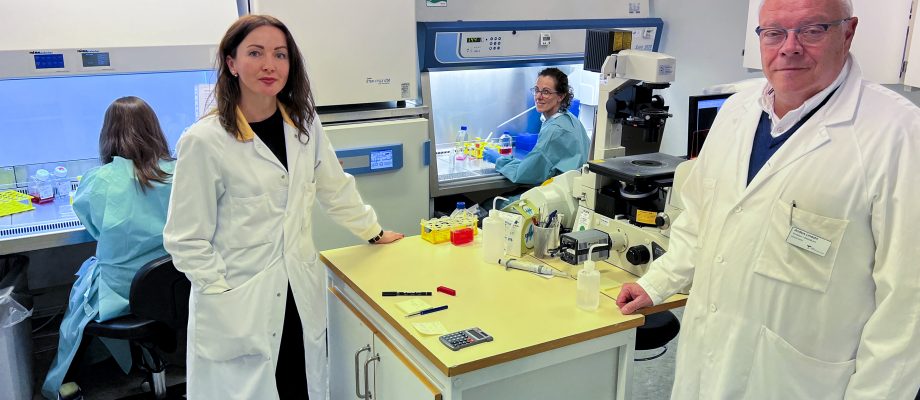RESEARCH COOPERATION. In the future, it is hoped that stem cells can be used to treat osteoarthritis, the world’s most common joint disease. Research is proceeding within AutoCRAT, a major European collaboration where the University of Gothenburg is one of the partners. Recently, members of AutoCRAT gathered for a plenary meeting at the Wallenberg Conference Center.
Arthritis, or osteoarthritis as the disease is also called, is a chronic disease that affects one out of four Swedes over the age of 45. Treatment currently consists mainly of physiotherapy and pain relief, but there is no cure for the disease.

Within a large European research collaboration, work is underway to make it possible to use stem cells to rebuild cartilage tissue that has been worn out. The research collaboration, known as AutoCRAT, has four years of funding from the European Union (EU). The collaboration includes researchers at universities, research institutes, and companies in Ireland, Italy, the Netherlands, Sweden, and Germany.
Stem cell-based treatment
Kristina Vukusic, a researcher at the University of Gothenburg, leads the Swedish part of the EU project.

“In AutoCRAT we develop new stem cell-based products, all of which have the potential to become a future treatment. Soon we need to agree within the project on which alternative is most likely to become a cell therapy for osteoarthritis, which we will test next year in a large animal model.”

The first option being investigated in the EU project is mesenchymal stem cells, a type of adult stem cell taken from adipose tissue or bone marrow. Another track is induced pluripotent stem cells, IPS, which is a method of inducing adult cells to become stem cells again. These cells can then be reprogrammed into cartilage cells, which can provide large amounts of cells that could serve the need ofmany patients. The third track concerns what are known as extracellular vesicles. These vesicles are small spheres of biological information that separate from the surface of the cell. They act as messengers between cells and may control the growth of cartilage cells or reduce inflammation in joints.
“Our research team in Gothenburg has extensive clinical experience cell therapy and has long been repairing cartilage. We assist the AutoCRAT project by providing cartilage cells that the end product can be compared with. We cultivate cartilage cells and examine their extracellular vesicles. For many years, we have developed new protocols where we differentiate IPS cells to become chondrocytes. In this way we hope to produce a universal donor for osteoarthritis patients.”
Inflammatory disease
Anders Lindahl, a professor at the University of Gothenburg and senior researcher in the EU projectAutoCRAT, was one of the first in the world to start working with cell therapy. In the early 1990s, he and his colleagues began treating patients with cartilage damage with the patient’s own cells. That treatment has become an approved cell therapy, which thousands of patients have received. Unfortunately, this form of treatment only works for patients with an isolated cartilage injury where there is healthy cartilage available and where the patient can be their own cell donor.

“The protocol that we are developing describes in great detail how to handle the cells during the differentiation to achieve the desired result. The collaboration within AutoCRAT will then lead to optimal automatic production, where a cell culture robot replaces expensive laboratory premises and high personnel costs. The goal is to produce large amounts of cells and functional extracellular vesicles with a protocol that makes it possible to treat a large number of patients suffering from osteoarthritis,” says Lindahl.
OSTEOARTHRITIS FACTS
- Osteoarthritis occurs when the cartilage in the joint gradually wears out. People with osteoarthritis have pain in individual joints, usually in the knees and often when they bear a heavy load.
- Osteoarthritis is the world’s most common joint disease. In Sweden, one out of four adults over the age of 45 has osteoarthritis, and the disease is most common among the elderly and women. It is a chronic disease that breaks down the tissue of the joints.
- Injuries, heredity, heavy work, and obesity are some of the causes. The disease can affect all joints in the body, but the knees and hips are most commonly afflicted. Osteoarthritis cannot be cured, but the right treatment can relieve the discomfort and pain.
BY: ELIN LINDSTRÖM











